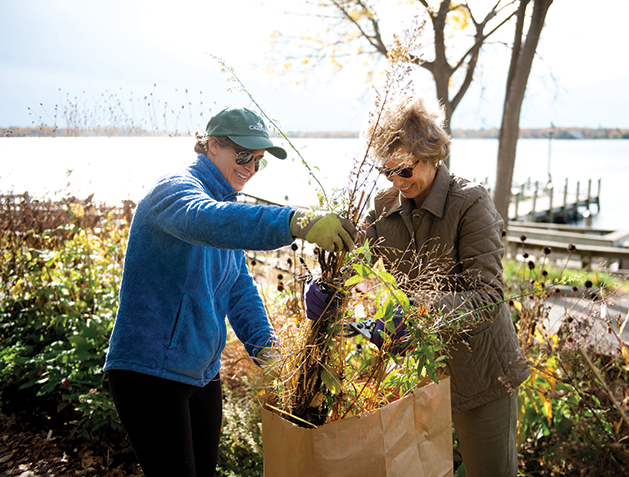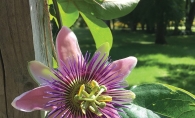
It might be hard to think about, but winter will be here in just a matter of months. Enjoy fall, by all means, but don’t forget about the ice and snow that will soon cover the ground—especially if you’ve got a garden to tend to. Fall is the perfect time to start getting a garden ready for winter. The Lake Minnetonka Garden Club tends to the garden at the historic Wayzata Depot and, every fall, hosts a series of cleanup days there to prep the garden for winter. These tips from member Nancy Guldberg, longtime coordinator of the annual fall cleanup, can apply to any garden of any size.
Tidy Up
Dying and diseased plants definitely need to go, especially if they’ve been affected by mildew or pest infestations. “You’ll want to clean up leaves and other debris that might be in there,” Guldberg says. “You could rake them up, you could use a leaf blower to blow them away or you could hand-pick them up. But if you’re cutting diseased plants, you want to make sure to use a clipper and make your cut clean—you don’t want to hurt the healthy parts of the plant or tree.”
Aside from any diseased plants, which will spread infections, browning leaves and old debris are fine to toss into your compost pile—just make sure your compost reaches a temperature of at least 140 degrees Fahrenheit to ensure all the bacteria is killed off.
Guldberg says she generally recommends waiting until the first frost of the season to start the cleanup process. “A lot of the leaves will be browned by then and be starting to dry, so you can tell what’s going to look good and what isn’t,” she says.
Protect Your Plants
Some plants are more sensitive to the cold than others. Guldberg says the species that tend to survive the winter on their own are usually native to Minn.
“One of the reasons there’s such a big push for native plants in gardens right now is because they have really deep roots, so they don’t need so much protection,” she explains. “Ones that aren’t native to the U. S. but have been brought here over the years could easily get frostbitten, so you’ll want to protect those.”
Mulch acts as a preventative against frostbite, providing extra insulation on top of the soil and lessening the likelihood that plant root systems will get shocked by sudden changes to the soil temperature.
Help Winter Wildlife
Once temperatures drop low enough, bugs die off and nectar is hard to come by, meaning the birds that stick around for the winter have a harder time finding food. Native plants have seed heads that provide much-needed sustenance for birds and other critters throughout the winter. “The birds will use those seed heads all winter long, and really, those seeds are the only thing that keep our birds alive,” Guldberg says. So keep those plants (which are mostly late-flowering perennials) standing upright and out of the compost pile while you’re doing your autumnal cleanup—Minnesota’s wildlife will thank you for it.
Pitch In
The Lake Minnetonka Garden Club boasts 120 members, all of whom take turns throughout the year planting, weeding, pruning and watering the Wayzata Depot gardens. Throughout the fall, four to six people each week assist with cleaning the gardens and gearing them up for the winter. The public is welcome at such community events, so if you’ve got an urge to join other horticulture enthusiasts, go for it. At two hours each week, the time commitment is minimal, but the results are huge. “It’s amazing how nice the garden looks just after a couple of hours a week,” Guldberg says.









